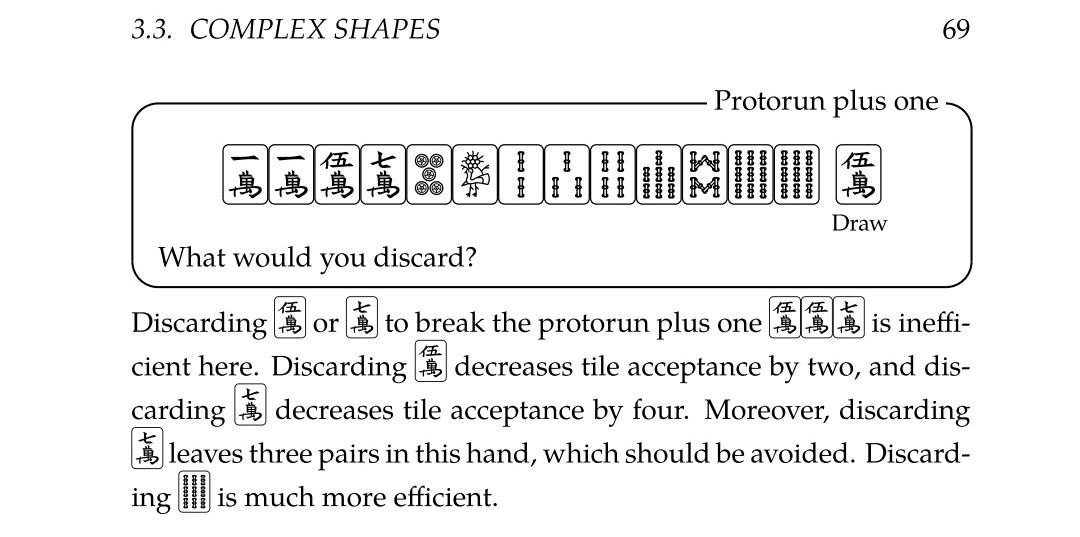- 5 Posts
- 8 Comments

 1·10 months ago
1·10 months agoThanks to your explanation I see my issue now. To find my 5 blocks I prioritize open waits, so I tend to see those kinds of 4 tiles shapes as 1 block + 1 useless tile. But if in the process I had to split a completed block into 1 open wait + 1 pair, my shanten goes back…
Splitting a completed block this way is very useful when I don’t have a pair yet, because the pair itself is a completed block so I essentially get a free open wait. But in this case I already had plenty of pairs so I just split a completed block into 2 uncompleted blocks, which I should do only when my hand doesn’t even have 5 blocks to begin with

 2·10 months ago
2·10 months agoHoly shit you’re right. Now I see it, thanks. Was it easy for you to see? Let me know if you have tips. I always look for 5 blocks, but here those that I saw were 333pin, 566pin, 23sou, 44sou and 668sou…

 1·1 year ago
1·1 year agoMahjong, Evangelion and Nadia…Now that’s a crossover I never expected to see. I wonder how good the AI was in these games back then ?

 2·1 year ago
2·1 year agoThank you very much! Yep that’s crystal clear now. I completely failed to notice my own 7sou pon, that changes everything indeed.
And even without it you’re right that although 8sou would be dangerous the 6man was definitely the most dangerous due to them not having discarded any manzu!
While in this case it turned out they were actually going for a 8sou wait and not manzu, they would probably have riichi’d upon tenpai, and they would to the contrary have been more likely to be damaten in case of manzu flush. I feel like I progressed a lot with that single thread thanks to you

 1·1 year ago
1·1 year agoWoops, something must have gone wrong with the link, here it is: https://game.mahjongsoul.com/?paipu=jljrno-03uu0v97-a10c-69if-fgfa-dinigjistwmu_a439702673_2
I see, I understand that 8 has statistically less chances to be a wait due to this. So if I had to choose between the 6man and the 8sou and all the other factors were equal, that alone would make 8sou the better choice.
However, in that case choosing the 8sou meant breaking tenpai. The gap between 1st and 2nd place is very small so if it were me, maintaining tenpai would take priority over this slight statistical advantage. Because it would not only allow a small chance to secure the victory with a win but also to avoid losing the 1st place due to noten penalty.
In summary in that situation I would prioritize my actions as such:
- folding with a tile safe against many players (and losing tenpai)
- discarding a tile safe against 1 player (and keeping tenpai)
- folding with a tile safe against 1 player (and losing tenpai)
To me it feels like he chose 3rd option even though 2nd was available. Which makes me believe it was actually 1st option and I just didn’t see how

 1·1 year ago
1·1 year agoWell damn you should be master 2 not expert 2! That actually makes perfect sense, no matter how good a hand can get, if you can’t complete it it’s worthless after all, and aiming for sanshoku is definitely easy to tell indeed. Thanks for your reply
I have no idea what the Showa period comment is about. Maybe there was a different mahjong meta at the time.
Yup they mentioned repeatedly throughout this manga that showa players rarely call (but never really explain why). There is even a flashback showing this character got his scar by getting sliced up for calling too much when he was young, so apparently that was no joke lol
Le riichi est un peu l’équivalent japonais du poker, du coup je ne sais pas si on peut appeler ça un jeu de société mais en tout cas c’est aussi complexe que passionnant. Même après plus d’1 an de pratique régulière je découvre encore de nouvelles règles

Thanks I didn’t know about this video series, very interesting! Now that I think about it Riichi Book 1 also mentions a rule of having optimally no more than 2 pairs, and even without any, that there’s no need to worry too much about securing a pair.
Apparently favoring the shuntsu over the pair is so obvious that in the below example Chiba doesn’t even consider discarding the 5pin holy shit…